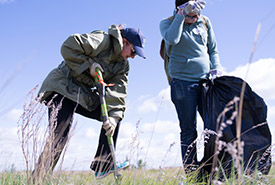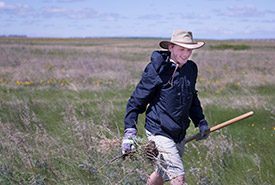My first CV event: Nexen Energy interns help remove weeds in the badlands

Nexen CV event, Horseshoe Canyon, AB (Photo by NCC)
Less than a week into my internship with the Nature Conservancy of Canada (NCC), I attended my first Conservation Volunteers (CV) event on June 5, 2014. The NCC team arrived early at the site, located on the Nodwell-Horseshoe Canyon property, to prepare for the day’s proceedings. To celebrate Environment Week, interns from Nexen Energy, a CNOOC Limited company, were on their way out to the property to take part in a day of hands-on volunteering and we were gearing up for their arrival.
Despite a clear blue sky and the promise of constant sunshine, the insistent, gusting wind brought the temperature down to single digits. Having grown up in Alberta and become accustomed to our erratic weather, I’d brought a multitude of layers. In my optimism I’d even packed a pair of shorts, which turned out to be the only article of clothing I did not put on that day.
While we awaited the arrival of our volunteers, the CV team educated me about the day’s event. Our primary goals were to remove absinthe (Artemisia absinthium), an invasive plant species, and to reseed with the native green needle grass while educating our volunteers about the area.
Absinthe, also known as wormwood, is recognized as the key ingredient in the absinthe liquor. Native to parts of Asia and Europe, this perennial plant has spread to North America and flowers annually across open areas and rangelands. Once established, it can be difficult to remove, as the seeds can linger for years before growing. In an effort to preserve the native badlands habitat on site, the removal of absinthe from the Nodwell property has been an ongoing project for NCC and its dedicated Conservation Volunteers.
Back to our day in the field: once the bus arrived with more than 40 eager Nexen Energy interns, I was armed with my camera and ready to capture the day.
The volunteers were divided into groups of three. Each group was given a shovel, a cup of native seed and a garbage bag to collect the weeds. To inspire their competitive sides, the CV team elected to make the absinthe collection into a contest and reward the teams who collected the largest quantity of weeds; the winners would be determined by weighing each team’s bags, and prizes would be awarded to the victors.
Initially, I will admit to some skepticism. Bundled in a sweater, jacket, and raincoat, and then huddled with my back to the wind, I surveyed some of the interns who emerged from the company bus in light jackets and shorts, and silently questioned the eventual success of our campaign. But once the groups were assigned and the tools given out, everybody seemed eager to begin, and the volunteers dove into their tasks with obvious enthusiasm.

Nexen CV event, Horseshoe Canyon, AB (Photo by NCC)
The weed pulling and seed sowing lasted the better part of the morning. Led by the CV team and their words of encouragement, the interns worked their way across the property, seemingly unaffected by the relentless wind or the temperature, colder then we’d like for the beginning of June but not necessarily unexpected in this fickle province. By the time we broke for lunch, 33 garbage bags full of absinthe had been collected, weighing a total of 1,305 lbs, and a handful of green needle grass seeds replaced each missing plant.
After lunch, Colleen McPhee, conservation coordinator for the Red Deer River Natural Area, led an interpretive hike into the canyon, pointing out some of the geologic features and the native plants that live here, including three-flowered avens, wild onion and prickly pear cactus.
Located 17 kilometres west of Drumheller, the Horseshoe Canyon is one of the best known sites in the Canadian Badlands, in which geological layers from the Cretaceous period are openly exposed. NCC owns 320 acres (130 hectares) of land along the western half of the canyon, and in collaboration with local landowners, they are invested in the preservation of this ancient geological manifestation.
The day concluded after the hike, despite some of the volunteers’ protests that they’d rather pull more weeds before returning to Calgary. All of the feedback we receive reiterated what a success the day had been, with a few comments requesting nicer weather in the future. Some of the comments we received at the end of the day were:
“I had so much fun with NCC! The staff were super friendly and helpful. I really enjoyed working outside and really felt we were making a difference!”
“This was a great opportunity to help maintain the environment and learn more about the area. I really enjoyed the experience!”
At the day’s end, the tired team piled back into the company vehicle with the type of satisfied fatigue born from a day of hands-on, meaningful work. If those interns were anywhere near as exhausted as I was, it must have been a very quiet bus ride back to the city.


